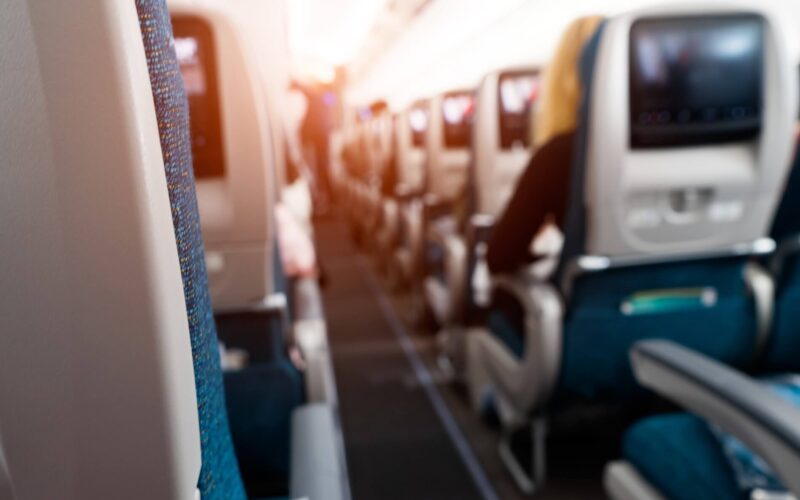The unwritten etiquette onboard an aircraft states that the one that gets the aisle seat, gets to enjoy the added extra room near the aisle, including fast access to the toilet if needs be. The passenger that sits by the window gets to control the window shade and enjoy a little bit more legroom by pushing his legs by the window.
And the one unlucky person that gets to sit in the middle has no advantage, if (s)he is traveling alone, that is. No access to the aisle and no access to the window’s shade does make for a fairly uncomfortable journey if you are unlucky with your seat row partners.
With the coronavirus outbreak, however, the middle seat is left even more unwanted. In a bid to improve passenger confidence, or to comply with regulations, some airlines are blocking out the middle seat completely. Others were trying to sell the option to block out the middle seat to a passenger himself, while others have responded very negatively to the idea of blocking middle seats.
No bookings allowed
Delta Air Lines, for example, has blocked the option to book the middle seat since mid-April. On May 5, 2020, the carrier made the decision to also block out select window and aisle seats on narrow-body and regional aircraft, like the Embraer E175 or the Bombardier CRJ200, to name a few aircraft from Delta Connection’s fleet.
United Airlines, another United States-based carrier, has opted to block passengers from booking seats next to one another or middle seats, where available.
On the other side of the globe, the Civil Aviation Administration of China (CAAC) limited international flights to a load factor of 75%, in order to contain the virus from getting into the country.
But full-service carriers, in part, could afford to block the middle seat. The very customer-oriented airlines do offer something else besides the ticket: from luxurious lounges (mostly closed due to the current situation) to the basic stuff like more legroom and comfort onboard the aircraft. Low-cost carriers, on the other hand, rely on cramming as many people as possible on their aircraft.
Ryanair managed to achieve a load factor of 96% in Q3 FY2020. Wizz Air, meanwhile averaged a 92% load factor in March 2020. The airlines that rely on high load factors to achieve a profit on a flight have been more vocal against blocking the middle seat.
Wizz Air chief executive officer Jozsef Varadi noted that if governments told airlines to block the middle seats, a third of their aircraft would be left empty.
“A 180-seater would become a 120-seater,” Varadi told Reuters.
A little less tame was Ryanair’s executive Michael O’Leary, who told that if governments want to do so, they can pay for the middle seats themselves, as “the middle seat does not deliver any social distancing,” calling the idea “kind of idiotic.”
International Air Transport Association (IATA), the trade association that represents around 290 airlines around the world, officially stated that the organization “does not support mandating social distancing measures that would leave ‘middle seats’ empty.”
Frontier Airlines, an ultra-low-cost carrier in the United States, got a bit cheeky with the idea. The company offered passengers the ability to purchase the middle seat to leave it empty. With the starting price of $39, Frontier was adamant that it was just a measure to offer travelers “extra peace of mind or simply additional comfort,“ stated Frontier Airlines‘ CEO Barry Biffle.
Following backlash from the decision, Frontier Airlines has decided against the idea. “We recognize the concerns raised that we are profiting from safety and this was never our intent,” stated Biffle.
Juggling confidence and rationale
Airlines now have to juggle two things at a time – customer confidence and rationale. While it sounds easy enough to juggle two things at once, carriers are also watching their liquidity reserves burning in front of them. Some carriers are spending millions per day with barely any revenue coming in.
The matter of the fact is, as O’Leary pointed out, blocking the middle seat delivers barely any social distancing measures. The World Health Organization (WHO) recommends maintaining a distance of at least 1 meter (3 feet) between people in order to avoid breathing in droplets of sneeze or cough that could contain viruses.
On Delta Air Lines’ 737-800s, for example, the seats are 17.2 inches (44 centimeters) wide. That means that if two people are sitting on the aisle and window seat, the distance between them is far from being enough to comply with the WHO recommendations.
IATA highlighted that if the middle seat would be left off, no narrow-body aircraft would be making a profit – the maximum load factor would be 67%, and even so, it is questionable how many passengers can airlines realistically attract during such low-confidence and financial downturn moments. Thus, airlines would either have to raise ticket prices, an option that butts heads against the current economic situation, or not fly at all, as they would burn even more cash – already a scarce resource.
The association predicts that if airlines were to fly with a load factor limit of 62%, the average limit across all aircraft types, ticket prices would go up on average by 43-54%. Even then, airlines would only break-even, which indicates that the hike in prices could be more severe to break a profit.
On the other hand, passenger confidence is very important. If travelers are wary of climbing onboard an aircraft, even the select few that are not affected by the current global financial downturn, airlines are stuck between a rock and a hard place trying to attract customers. Keeping passengers confident that their journey poses no danger to health could be the only saving grace during such troubling times.

